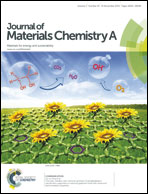Roughness-controlled copper nanowires and Cu nanowires–Ag heterostructures: synthesis and their enhanced catalysis†
Abstract
Effective surface and interface control of metal nanomaterials provides a powerful tool for achieving their enhanced catalytic properties. This article reports a remarkably simple approach for the preparation of copper nanowires with a rough surface. Surface roughness of Cu nanowires can be successfully controlled by adjusting the reactant ratio of the same type of element ions with different valence state (Cu+ and Cu2+). Furthermore, it is noted that the as-prepared rough Cu nanowires have higher BET surface areas and a porous structure with a total pore volume of 4.212 nm. Cu nanowires–Ag heterostructures are further prepared using the as-prepared rough Cu wires as the “substrate”. Our experimental results reveal that Ag nanocrystals preferentially grow on nanowires with a rough surface morphology compared to smooth nanowires. Due to the surface effects and synergistic effect of their constituents, the as-prepared rough copper nanowires and Cu nanowires–Ag heterostructures demonstrated highly enhanced catalytic performance for the reduction of 4-nitrophenol. In particular, the Cu nanowires–Ag heterostructures show superior catalytic activity than the as-obtained Cu nanowires with smooth surface, and some recently reported noble metal catalysts, such as pure Ag nanowires, magnetic Au nanocrystals, and Au/graphene hydrogel. This study offers a simple strategy that could be applied for the fabrication of other promising one dimensional Cu-based bimetallic nanomaterials.


 Please wait while we load your content...
Please wait while we load your content...